Spain!
Top-Rated Tourist Attractions in Spain
The grandeur of a caliph's palace, sybaritic sun-drenched Mediterranean beaches, the staccato stamp of a flamenco dancer's heels, the awed hush of pilgrims entering the cathedral at Santiago de Compostela after weeks of walking El Camino. You can find the soul of Spain in tourist attractions such as these, which represent the country's tumultuous history, rich culture, and enchanting natural beauty.
From the sunlight playing endlessly off the "scales" of Gehry's Guggenheim Museum and the throbbing street life of La Rambla and Plaza Mayor to the forest of columns and Moorish arches disappearing into the silent expanse of Cordoba's Great Mosque, Spain exudes a vibrant energy and a captivating blend of past and present. Plan your sightseeing adventures and things to do with our list of the top attractions in Spain.
1. The Alhambra and Generalife Gardens, Granada
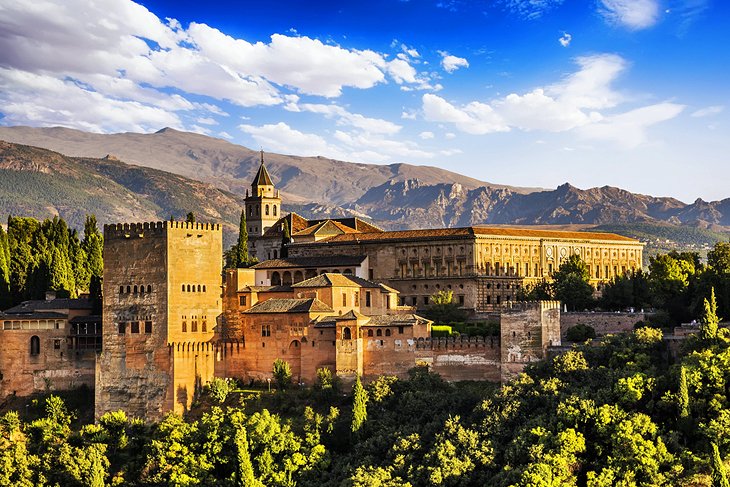
The Alhambra and Generalife Gardens, Granada
No matter how much you have read or how many pictures you have seen of Granada's Alhambra palaces, this Moorish pleasure palace will still take your breath away. The Nasrid dynasty's royal palace is the artistic highlight of Spain's Islamic period, when Al-Andalus — as they called Andalucía — represented the epitome of culture and civilization in Europe's Middle Ages.
The Alhambra complex includes several buildings, towers, walls, gardens, and a mosque, but it's the indescribably intricate stone carvings, the delicate filigrees, the magnificent tile-lined ceilings, the graceful arches, and serene courtyards of the Nasrid palace that will haunt your dreams.
That said, the adjoining palace built for the Emperor Charles V, even in its unfinished state is the finest example of High Renaissance architecture in Spain. And Generalife's terraced gardens offer a peaceful respite from the grandeur, and splendid views back at the rest of the Alhambra.
2. Barcelona's Sagrada Familia and Gaudi Sites
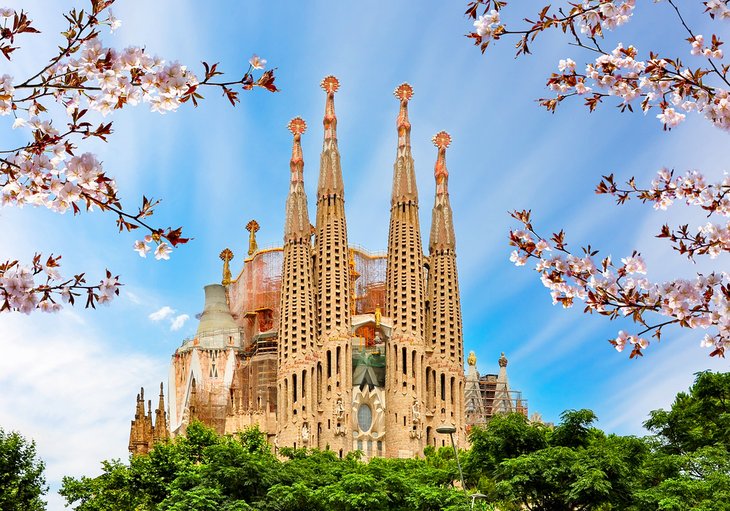
Barcelona's Sagrada Familia and Gaudi Sites | Leandro Neumann Ciuffo / photo modified
Antoni Gaudi took the architectural style known as Art Nouveau a step further, even, some have argued, into absurdity. The fanciful and outrageous buildings he created in Barcelona have become landmarks, the signature attractions of this Catalan city. Foremost is The Sagrada Família church, officially the Temple Expiatori de la Sagrada Família or the Holy Family Church of the Atonement. One of Europe's most unconventional churches, it is also unfinished, so as you look down from its tower, you can see the work in progress below.
You may search in vain for absolute straight lines in Gaudi's Casa Milà, his last and most famous secular work; it resembles a piece of sculpture more than a functional building. Be sure to ascend to its roof — the chimneys are said to have inspired the image of Darth Vader from Star Wars.
Parc Güell overlooks the city from a hillside, the views and gardens framed by fantastical creatures — salamanders, fish, an octopus — and designs in bright ceramic-chard mosaics. A fanciful towered house near the entrance is largely covered in colored ceramics. Unlike most buildings, Gaudi's appeal even to children and to adults who don't care a thing about architecture, for one simple reason — they are just plain fun to look at.
3. The Great Mosque of Cordoba (Mezquita)
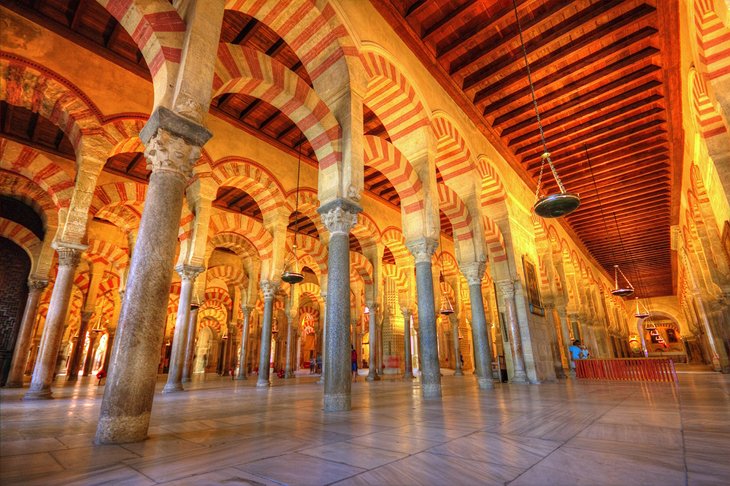
The Great Mosque of Cordoba (Mezquita)
Once the principal mosque of western Islam and still known as the Mezquita, Cordoba's mosque is one of the largest in the world and the finest achievement of Moorish architecture in Spain. In spite of later alterations that carved out its center to build a Catholic cathedral at its heart, the Great Mosque ranks with the Alhambra in Granada as one of the two most splendid examples of Islamic art and architecture in western Europe.
Building materials from Roman and Visigothic buildings were used in the construction, which began in 785, and by 1000, it had grown to its present dimensions, its prayer hall with no fewer than nineteen aisles. No matter where you stand or which direction you look, its rows of columns and rounded Moorish arches line up in symmetrical patterns.
Narrow, winding streets; small squares; and low whitewashed houses with beautiful patios visible from the street fill the old Juderia around the mosque, a Moorish atmosphere inherited from its past.
4. The Prado and Paseo del Artes, Madrid
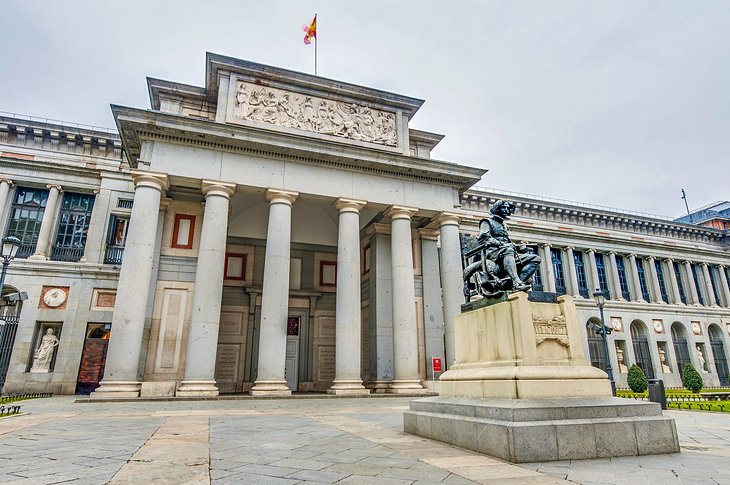
The Prado and Paseo del Artes, Madrid
The Prado alone ranks with the world's top art museums for the riches of its collections. But add the Reina Sofia National Art Museum, the Thyssen-Bornemisza Museum, and the CaixaForum, all along Madrid's mile-long, tree-shaded boulevard, and you have what may be the world's highest concentration of priceless art treasures. It's no wonder this is known as El Paseo del Arte — Boulevard of the Arts.
After a 2007 expansion that doubled its exhibition space, the Prado added another 12 galleries in 2009 to house a collection of works by Goya and other late 19th-century artists. The Prado has the world's largest collection of Spanish art, an impressive continuum from 12th-century medieval works through the avante-garde movement of the early 20th century, and is especially noted for its works from Spain's golden age by El Greco, Velazquez, and Goya.
But its riches are not all Spanish; other highlights are the medieval murals and retablos, paintings by Flemish and Dutch artists (be sure to see the fantasy world of Hieronymous Bosch and works by Rubens and Brueghel), and Italian art (Botticelli, Raphael, Correggio, Titian, and Tintoretto).
Highlights of the Reina Sofia's impressive 20,000 works are Picasso's Guernica and works by Miró, Dalí, Dubuffet, Braque, Serra, Calder, and Magritte.
5. San Lorenzo de El Escorial
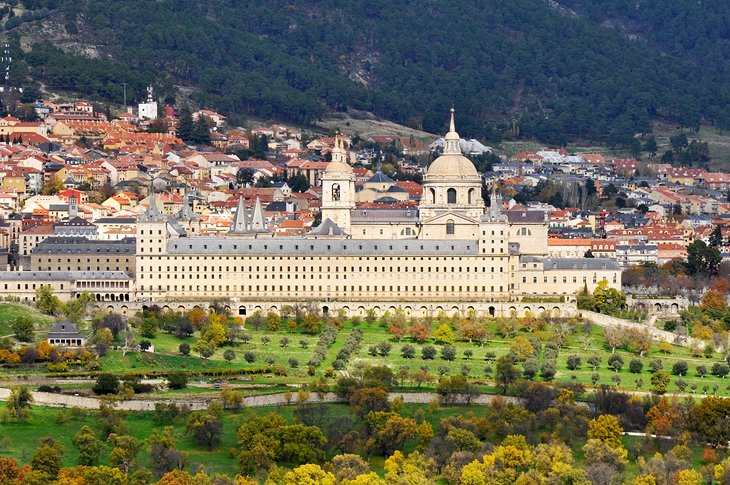
San Lorenzo de El Escorial
San Lorenzo de El Escorial, about 45 kilometers northwest of Madrid, was the summer home of Spain's kings, and in 1563, work was begun here on a huge complex, which would include a monastery, church, royal palace, mausoleum, library, and museum, all conceived as a monument to Philip II and his reign. The result is a staggering collection of attractions, built around 16 courtyards, its rooms and structures connected by 16 kilometers of corridors. At its core is the church, the highlight of which is Herrera's 30-meter-high retablo, made of jasper and red marble and approached by a flight of 17 steps.
Along with the vaulted and frescoed ceilings by Tibaldi in the rooms off the lower cloister, highlights of the monastery are the Panteón de los Reyes (the Baroque burial vault of the Spanish kings) and the library, a grand room also decorated by Tibaldi frescoes.
In the palace, be sure to see the Bourbon Suite, where the state apartments of Charles IV are decorated with rare furnishings and 338 tapestries. Beyond are the art-filled private apartments of Philip II. The Picture Gallery below has a large collection of fine paintings, including works by Hieronymus Bosch, Albrecht Dürer, Titian, Tintoretto, Veronese, Velázquez, and El Greco.
- 6. Guggenheim Museum, Bilbao
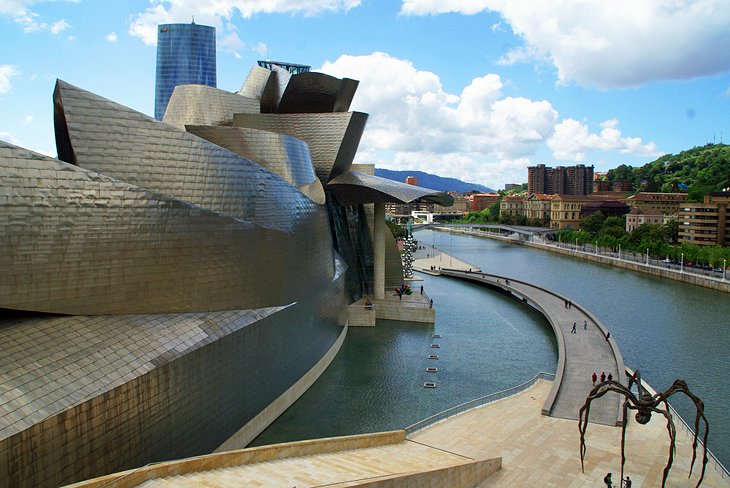
Guggenheim Museum, Bilbao
You really have to see this building to believe it — no photograph has ever done justice to this symphony of shapes, so alive that they seem ready to take wing. American architect Frank Gehry used blocks of limestone and undulating sheets of titanium to turn the notion of modern architecture on its ear. So thoroughly did he succeed that two new terms were born from it: "The Bilbao Effect" — the ability of a city to turn its fortunes around by constructing a single world-class building — and "architourism," a whole segment of the travel industry revolving around landmarks of contemporary architecture. Inside the museum are traveling exhibitions and rotating displays of its own collections of modern art.
7. Seville Cathedral and Alcazar
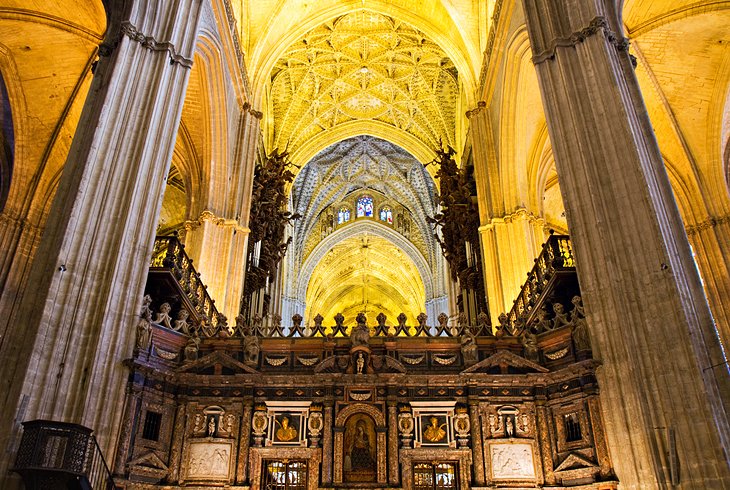
Seville Cathedral and Alcazar
La Giralda tower, Seville Cathedral, and the Alcazar combine to form a UNESCO World Heritage Site. The tower is a minaret, a "masterpiece of Almohad architecture," according to UNESCO. The cathedral has more interior space than St. Peter's in Rome and a 37-meter main altar of carved statues completely covered in gold. The monumental tomb of Christopher Columbus is held aloft by a quartet of larger-than-life figures. La Giralda, the emblem of Seville, began life as a minaret and is all that's left of the city's Great Mosque, destroyed to build the cathedral.
The Alcazar opposite was begun by the Moors in 712 and continued after the Christian re-conquest by King Pedro in the 1300s in the ornate neo-Moorish style called Mudejar. The rooms and salons are breathtaking, and the gardens a joy to stroll in, shaded by fragrant orange and lemon trees. Adjoining on the east is Santa Cruz, the former Juderia (Jewish Quarter), a neighborhood of whitewashed homes, iron balconies, and flower-filled courtyards.
8. Santiago de Compostela Cathedral
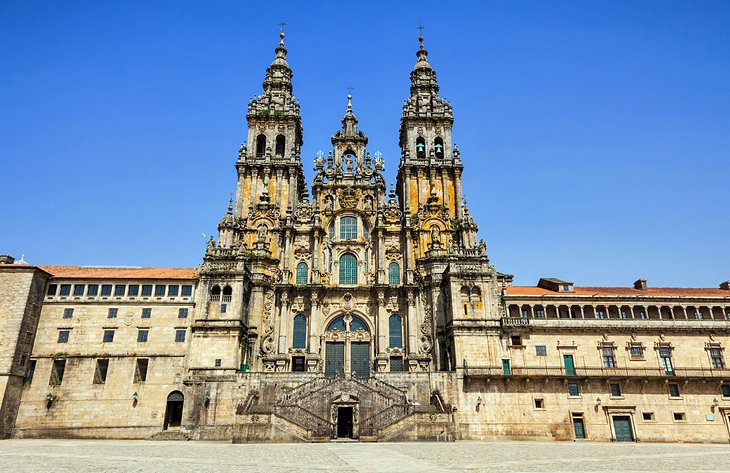
Santiago de Compostela Cathedral
The magnificent cathedral of Santiago (St. James) was built to house and honor the relics of the saint, and it has been the goal of pilgrims since the Middle Ages, the culmination of their completing the famed Camino de Santiago. One of the outstanding monuments of Early Romanesque architecture, the cathedral was built between 1060 and 1211, and despite the Baroque transformation of the exterior in the 16th to 18th centuries, the interior is still in the purest Early Romanesque style.
You'll see both of these periods at play as you enter the west front, through one of Spain's most impressive church facades. Step inside to face the Pórtico de la Gloria, part of the old west front now concealed by the 18th-century facade. This triple doorway is one of the largest and most magnificent collections of Romanesque sculpture in the world.
The focal point of the interior is the elaborately decorated Capilla Mayor, built over the Apostle's tomb. In the center of the high altar of jasper, alabaster, and silver is a 13th-century wooden figure of the Apostle, richly adorned in precious metals and gems. On either side, narrow staircases lead up behind the figure so that pilgrims can kiss the Apostle's cloak - culminating their pilgrimage. In a crypt under the altar, the Apostle's remains are in a silver casket.
9. Plaza Mayor, Madrid
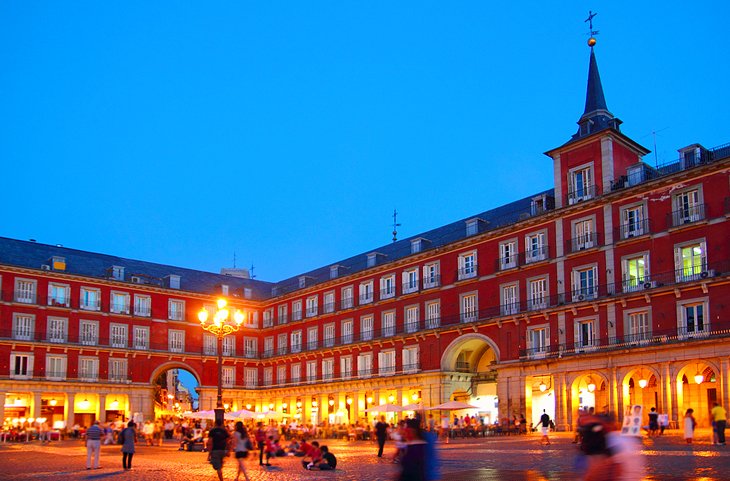
Plaza Mayor, Madrid
The throbbing heartbeat of Spain's vibrant capital city, Plaza Mayor has played an important part in Madrid life since the 16th century, when Philip II entrusted the task of designing it to his favorite architect Juan de Herrera, builder of the Escorial. It has served as the stage for ceremonial events — the proclamation of a new king, the canonization of saints, the burning of heretics — and public entertainment such as chivalric tournaments and bullfights. The cafes reaching out onto its pedestrian-only stone pavement, and the restaurants shaded under its arcades are Madrid's living room, popular meeting places for Madrileños and tourists alike.
10. Ciudad de las Artes y las Ciencias, Valencia
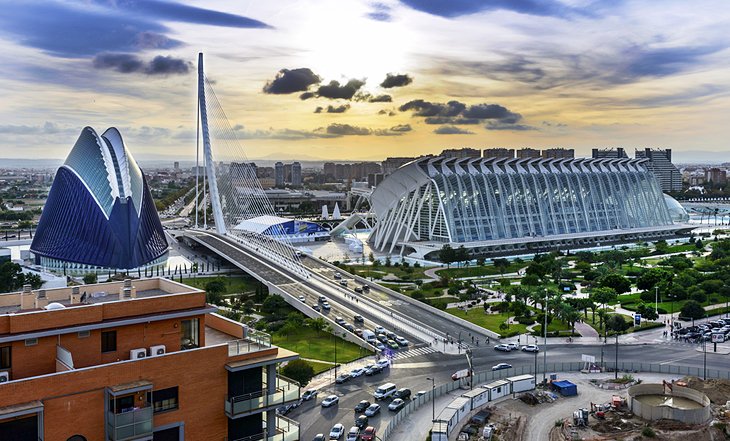
Ciudad de las Artes y las Ciencias, Valencia
When Valencia diverted the course of the river that had repeatedly flooded the city, it was left with a broad, flat riverbed spanned by bridges. It was upon this clean palette that the brilliant Spanish architect Santiago Calatrava created a breathtaking ensemble of structures that have become a magnet for aficionados of contemporary architecture. Not only the buildings, but the museums, arts venues, and aquarium (by Félix Candela and the only building not designed by Calatrava) form a series of tourist attractions that rank among Spain's most popular. Europe's largest oceanographic aquarium, L'Oceanogràfic, was built in the shape of a water lily with buildings dedicated to different aquatic environments from the tropics to the poles.
11. Costa del Sol Beaches
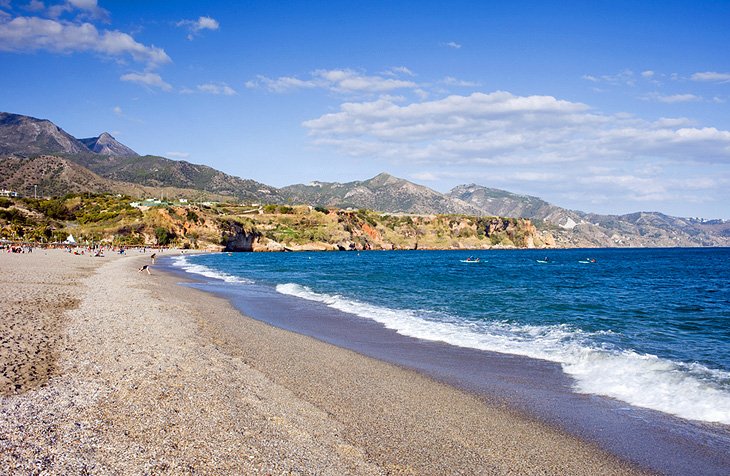
Costa del Sol Beaches
With the record as Europe's sunniest place, and mile after mile of white sands lapped by gentle seas, it's no wonder that the Costa del Sol beaches are the goal of sun-starved northern Europeans looking for sun-and-sand getaways. This popularity caused serious over-development initially, but the Andalucian government has not only put a stop to this, it has begun the process of tearing down the worst offenders and returning entire sections of coast to natural landscapes, clean beaches, and attractive new buildings that are more in harmony with their surroundings.
The beaches are not Costa del Sol's only attraction for tourists. Revitalizing its hub city of Málaga has made this coast even more alluring to everyone. Yachtsmen love the smart marina of Puerto Banus, and avid golfers head west from Marbella's old-world charms to Nueva Andalucia, known as Golf Valley for its more than 50 courses. A few steps from the beach in Marbella is the old town of whitewashed houses and well-preserved remains of the Moorish Castillo.
12. La Rambla, Barcelona
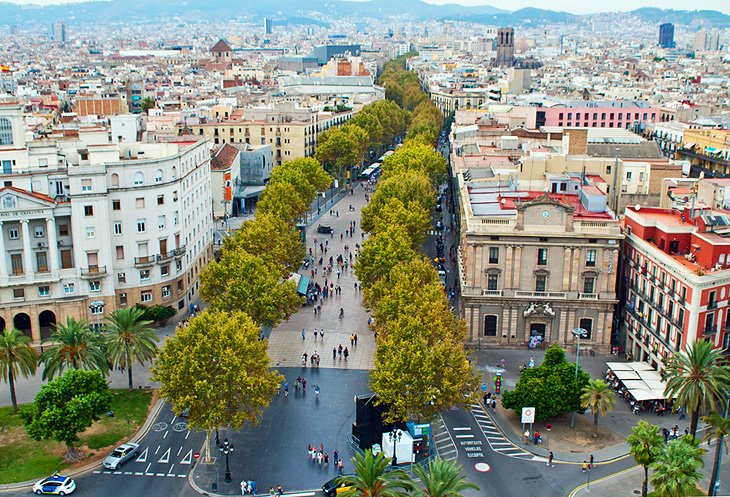
La Rambla, Barcelona
Strolling along La Rambla on a summer evening, you might think that every single one of Barcelona's inhabitants was there with you. It's definitely the place to be after work on a summer evening or on a weekend. This tree-lined boulevard cuts a green line — not a very straight one — through the city center, stretching northwest from the Columbus Memorial near the port.
The section to the Plaça de Catalunya is lined with plane trees, its wide pedestrian zone flanked by a narrow road on each side. Along with its flower and bird markets, La Rambla has a number of book and newspaper stands, as well as restaurants and cafes with open-air tables. Pavement artists, street musicians, living statues, and impromptu performers all add to its lively atmosphere.
13. Toledo's Old City
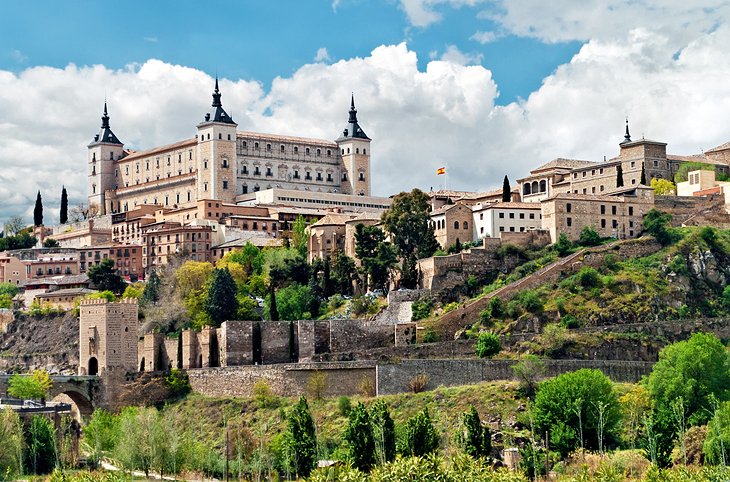
Toledo's Old City
Moorish, Gothic, and Renaissance architecture mingle and blend into a city that El Greco captured in one of his most famous paintings. High on a granite hill and surrounded on three sides by the deep gorge of the Tagus River, it presents a stunning profile; approaching it from below is an unforgettable sight.
The layout of the town, with its irregular pattern of narrow streets and numerous blind alleys, reflects its Moorish past, and the architecture of the Christian period is represented by the numerous churches, convents, and hospices. This makes the old city a kind of open-air museum, illustrating the history of Spain, and it has been listed by UNESCO as part of mankind's cultural heritage. The Gothic cathedral is splendid, its interior richly decorated, and the two synagogues in the atmospheric old Juderia are ornate in the Moorish style. While in that quarter, be sure to see the church of San Tome for its El Greco masterpiece.
14. The White Towns of Andalucía
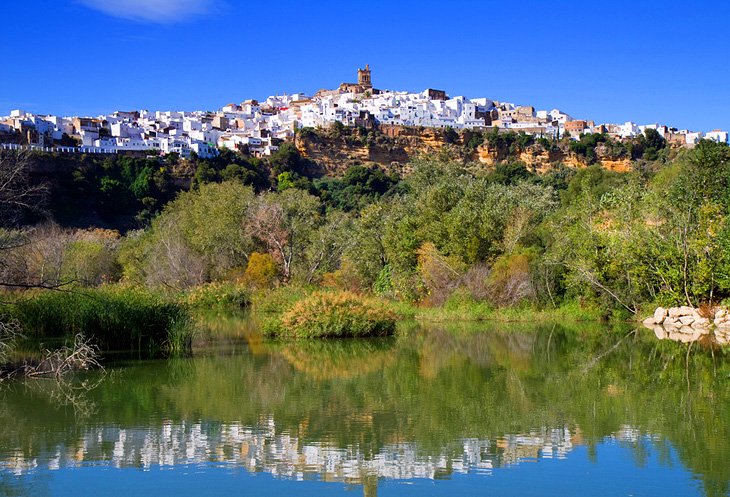
Arcos de la Frontera
Poised like dabs of white frosting atop the steep crags of southern Andalucía, the White Towns are not just beautiful, they speak of this region's long and fascinating history. West of Gibraltar, mountains rise straight from the sea, and among them hide these White Towns, each on its hilltop.
Most spectacular is Arcos de la Frontera, whose plaza beside the Gothic church ends vertiginously in a 137-meter cliff, affording views across a valley of olive, orange, and almond orchards. Its maze of winding cobbled streets lead past cafes and craft shops selling ceramics and pottery to a Moorish castle.
A total of 19 of these villages of small white houses are in the area around the Grazalema Nature Reserve. Grazalema and Zahara de la Sierra are two others worth seeing. A good base in the region is Jerez de la Frontera, home of flamenco and Andalucian thoroughbreds. Watch these horses' precision ballet at the Royal Andalucian School of Equestrian Art, and for authentic flamenco, visit Centro Cultural Flamenco.
15. El Teide, Tenerife
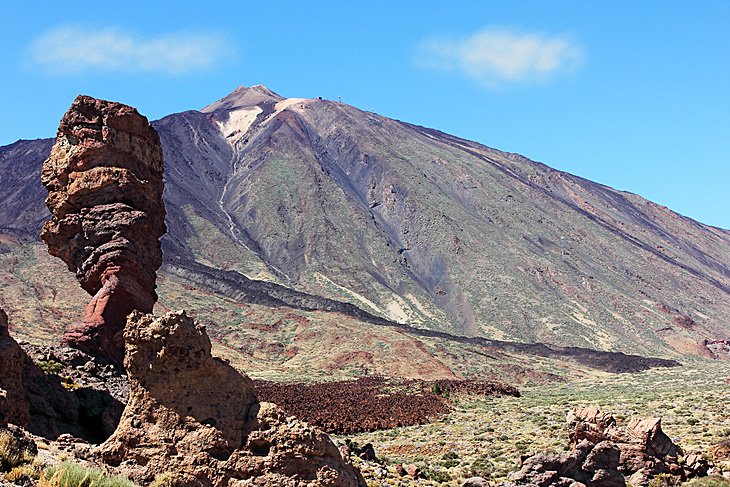
El Teide, Tenerife
The highest peak in Spain, this ancient — but still simmering — volcano is also one of Europe's top natural wonders. The Pico de Teide and the Caldera de las Cañadas, a gigantic volcanic crater, together form the Parque Nacional del Teide, at the center of the island of Tenerife. In listing the park in 2007, UNESCO cited its natural beauty and "its importance in providing evidence of the geological processes that underpin the evolution of oceanic islands."
You can explore El Teide in several ways. You can drive or hike across the inside of the caldera — the crater floor — 12 miles in diameter and a barren moonscape of colored rock formations that's like driving into the center of the earth. You can climb El Teide's cone, but an easier way to get close to the top is by an eight-minute cable car ride. On a clear day, views cover the entire archipelago and can extend to North Africa — the nearest land mass to the Canary Islands.
(thanks to: www.planetware.com)
Comments
Post a Comment